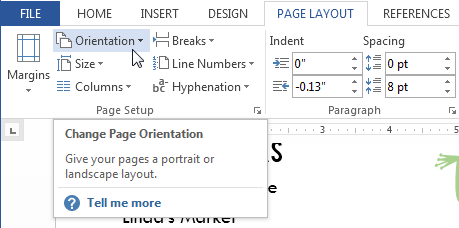Navigating the Vast Canvas: An In-Depth Exploration of Discoverable Layout Options in Microsoft Word 2013

Introduction:
In the ever-evolving landscape of document creation and design, the layout of a document plays a pivotal role in conveying information effectively. Microsoft Word 2013, a cornerstone in word processing software, introduces an array of discoverable layout options that empower users to craft visually appealing and structured documents. This comprehensive article takes an in-depth look at the wealth of layout options available in Microsoft Word 2013, unraveling their nuances and showcasing how they contribute to a dynamic and user-friendly document creation experience.
The User-Friendly Interface:
At the core of Microsoft Word 2013’s discoverable layout options lies a user-friendly interface that caters to both novice and experienced users. The layout-related features are thoughtfully organized within the Ribbon, making them easily accessible under the “Layout” tab. From the simplicity of one-click options to the depth of advanced settings, users can effortlessly navigate and discover the wealth of layout tools available at their fingertips.
Document Orientation and Size:
Microsoft Word 2013 recognizes the diversity of document needs and provides users with the ability to easily customize the orientation and size of their documents. The “Orientation” option allows users to switch between portrait and landscape modes, catering to different types of content. Furthermore, the “Size” option offers a range of predefined paper sizes, from standard letter to legal and more, ensuring that documents are optimized for various printing and presentation requirements.
Margins and Page Setup:
The discoverable layout options in Microsoft Word 2013 extend to precise control over margins and page setup. Users can effortlessly adjust margin widths using preset options or opt for custom margins to meet specific formatting needs. Page setup features, including page breaks, provide a granular level of control, allowing users to structure their documents with the utmost precision.
Columns and Text Flow:
For users seeking dynamic text layouts, Microsoft Word 2013’s discoverable options for columns and text flow are invaluable. Under the “Layout” tab, users can easily configure the number of columns in a document, fostering a magazine or newsletter-style aesthetic. The “Text Direction” feature enables users to create visually striking documents with text flowing in different directions, adding a layer of creativity to document design.
Breaks and Section Management:
Navigating the complexities of document structure becomes seamless with the “Breaks” and section management options in Microsoft Word 2013. Users can insert various types of breaks, such as page breaks or section breaks, allowing for the creation of distinct sections within a document. This level of organization proves essential for complex documents, enabling users to control formatting independently in different sections.
Headers and Footers:
The discoverable layout options in Microsoft Word 2013 extend to the realm of headers and footers, offering users the ability to customize these sections effortlessly. Users can select from predefined header and footer layouts, insert page numbers, and even add elements like date and time stamps. This feature is particularly crucial for creating professional and polished documents with consistent branding.
Watermarks and Page Borders:
Microsoft Word 2013’s layout options include the capability to add watermarks and page borders, enhancing the visual appeal of documents. Users can choose from a variety of preset watermarks or create custom ones to personalize their documents. The page border feature allows users to define borders with different styles, colors, and widths, adding a touch of elegance to their document presentations.
Grids and Guides:
Precision in document layout is a cornerstone of Microsoft Word 2013’s design philosophy. The software provides discoverable options for grids and guides, empowering users to align elements with accuracy. The gridlines are visible in the background, aiding users in maintaining consistent spacing and alignment throughout the document. Guides can be dragged onto the document canvas, offering a dynamic way to structure content.
Themes and Styles:
Discoverable layout options in Microsoft Word 2013 extend beyond the structural elements to include themes and styles. Themes provide users with a quick and cohesive way to apply a unified design to their documents. The “Styles” feature allows users to create consistent formatting for headings, paragraphs, and other text elements, ensuring a polished and professional look across the entire document.
Live Preview and Experimentation:
One of the standout features of discoverable layout options in Microsoft Word 2013 is the Live Preview functionality. Users can hover over different layout options, and the document preview dynamically updates to showcase the potential impact of each choice. This hands-on approach to layout customization enables users to experiment with different settings without committing to changes, fostering a creative and iterative document design process.
Responsive Design for Diverse Needs:
Microsoft Word 2013’s commitment to discoverable layout options is further exemplified by its responsiveness to diverse document needs. Whether users are crafting a formal report, designing a creative flyer, or compiling a research paper, the layout options adapt to various contexts. This versatility ensures that Microsoft Word 2013 remains a go-to tool for users across industries and disciplines.
Conclusion:
As we traverse the expansive realm of document creation, Microsoft Word 2013’s discoverable layout options stand as a testament to the software’s commitment to user empowerment and creativity. From fundamental structural elements to intricate design details, every facet of document layout is meticulously catered to within the user-friendly interface. Whether crafting a simple letter or designing a complex report, users can unlock the full potential of layout customization, transforming their ideas into visually compelling and well-structured documents. Microsoft Word 2013’s discoverable layout options redefine the document creation experience, inviting users to explore, experiment, and craft documents that not only convey information but also captivate and engage. Welcome to a world where layout customization is not just a feature but a dynamic and discoverable journey – a world shaped by Microsoft Word 2013’s commitment to excellence in document design.







